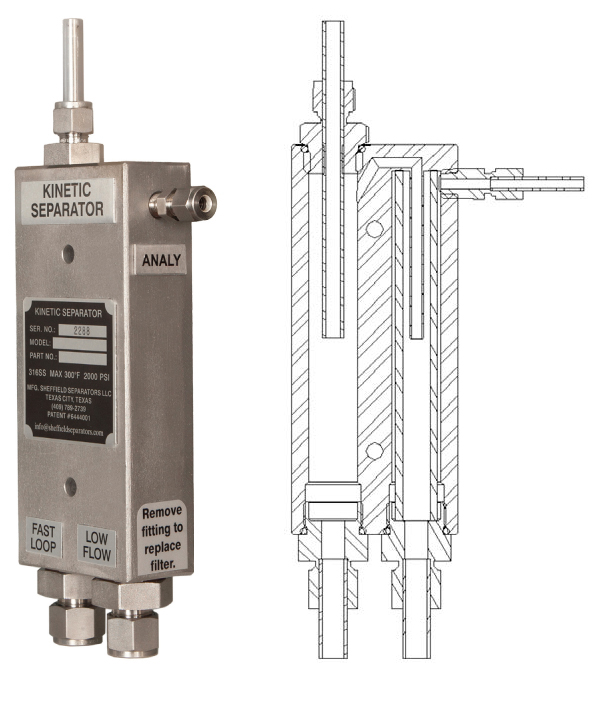The SS 700-GF-S1 is recommended for gas samples with light to moderate particulate and light to moderate liquid contamination. These routine applications require a high performing, reliable separator with excellent hydrophobic filtration. The SS 700-GF-S1 is recommended for all but the most demanding applications. The Sheffield patented dual chamber separator provides maximum separation of condensable and particulate while the second, polishing chamber provides final clean-up.
Kinetic Separation Technology is the most innovative technology available today for sample conditioning.
The Sheffield patented dual chamber separator provides maximum separation of liquids and particulate. Although kinetic energy will physically separate impurities, it will not alter the chemical composition of the sample.
Features |
Benefits |
|
| Extremely Versatile | Operates across a wide range of pressure, flow rates, and temperatures | |
| Hydrophobic Fluorocarbon Teflon® lined filters | Can handle significant amounts of free water or particulate without clogging | |
| Kinetic Energy Separation results in 4 fold expansion in first chamber and 254 magnitude in second chamber, producing cooling. Joule-Thomson effect. | The lower temperature at the kinetic separation results in greater condensing, further maximizing separation | |
| Operates at 2psi or less differential pressure | Will not push water through the hydrophobic filter | |
| Dual chamber construction | Maximizes separation and Filtration; longer filter life | |
| No moving parts | Less maintenance greater reliability | |
| Straight fittings with O-ring seals | Easier filter changes | |
| No internal obstructions in first chamber | Minimal backpressure |
The Sheffield Kinetic 7” Separator uses kinetic energy to separate the representative analyzer sample from impurities found in a process stream. This is accomplished by establishing a flow path through the 1st chamber and reversing the flow of a relatively small Bypass sample. Solid contaminants and immiscible liquids in the liquid samples will not negotiate this complete reversal of flow direction and exit the bottom of the separator. The Kinetic Energy caused by this reversal initially removes the impurities from the Bypass stream through gravity and inertia. To further effect this separation and filtration a second kinetic chamber with a hydrophobic filter polishes the sample. The second chamber also experiences Kinetic Energy Separation and removes the remaining impurities from the Slip Stream. The sample is lighter than immiscible liquids and solids (particulates) in a liquid sample.
How It Works
Initially, the flow path enters the first chamber. System pressure forces a reduced Bypass flow in the reverse direction; the main stream flow continues through the first chamber and exits the bottom of the separator. Gravity, inertia, and cooling cause kinetic separation of the Bypass stream because the representative sample is lighter than condensate and particulate in a gas sample.
The First Chamber of the Sheffield Kinetic Separator is designed for installation directly in-line to the Fast Loop sample transport system or in the Bypass Loop. Most of the heavier contaminates are separated in the first chamber. The walls of this chamber lined with PTFE Teflon to repel condensables and particulate.
The Second Chamber separates and filters only the relatively small amount of Slip Stream sample going to the analyzer which greatly enhances filter life. The second chamber is a kinetic energy polishing chamber, aided with a special 6” 2 or 15 micron Teflon®-lined, hydrophobic, self-cleaning low pressure drop filter. The filter element in this chamber has a special
Teflon®-lined interior, which repels water and particles as these impurities pass through the filter. Finally, both chambers exit the bottom of the separator to a common juncture with the return flow. These attributes combine to make the Sheffield Kinetic Separator virtually maintenance free.
The SS700GF-S1 is the 7” separator designed after the original 12” separator.It is designed for medium to medium/heavy particulate and water removal. It has a smaller foot print for tight locations like sample conditioning panels but maintains significant separation capacity.
Maximum Pressure: 2,000 PSIG
Minimum Pressure: 2 PSIG – Vacuum application with pump or eductor
Maximum Temperature: 300° F
Pressure Drop: 2 PSIG
Flow Rate: The flow rate specified for the sample system is sufficient for the separator. For best results, the first chamber flow should exceed that of the second chamber.

